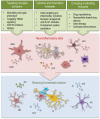Neuroimmune crosstalk in chronic neuroinflammation: microglial interactions and immune modulation
- PMID: 40260075
- PMCID: PMC12009833
- DOI: 10.3389/fncel.2025.1575022
Neuroimmune crosstalk in chronic neuroinflammation: microglial interactions and immune modulation
Abstract
Neuroinflammation is a fundamental feature of many chronic neurodegenerative diseases, where it contributes to disease onset, progression, and severity. This persistent inflammatory state arises from the activation of innate and adaptive immune responses within the central nervous system (CNS), orchestrated by a complex interplay of resident immune cells, infiltrating peripheral immune cells, and an array of molecular mediators such as cytokines, chemokines, and extracellular vesicles. Among CNS-resident cells, microglia play a central role, exhibiting a dynamic spectrum of phenotypes ranging from neuroprotective to neurotoxic. In chronic neurodegenerative diseases, sustained microglial activation often leads to the amplification of inflammatory cascades, reinforcing a pathogenic cycle of immune-mediated damage. Intercellular communication within the inflamed CNS is central to the persistence and progression of neuroinflammation. Microglia engage in extensive crosstalk with astrocytes, neurons, oligodendrocytes, and infiltrating immune cells, shaping both local and systemic inflammatory responses. These interactions influence key processes such as synaptic pruning, phagocytosis, blood-brain barrier integrity, and cytokine-mediated signaling. Understanding the mechanisms of cell-cell signaling in this context is critical for identifying therapeutic strategies to modulate the immune response and restore homeostasis. This review explores the key players in CNS neuroinflammation, with a focus on the role of microglia, the molecular pathways underlying intercellular communication, and potential therapeutic approaches to mitigate neuroinflammatory damage in chronic neurodegenerative diseases.
Keywords: astrocytes; cytokines; immune cells; microglia; neurodegenerative diseases; neuroimmune crosstalk; neuroinflammation; neurons.
Copyright © 2025 Müller and Di Benedetto.
Conflict of interest statement
The authors declare that the research was conducted in the absence of any commercial or financial relationships that could be construed as a potential conflict of interest.
Figures


Similar articles
-
Neuronal injury in chronic CNS inflammation.Best Pract Res Clin Anaesthesiol. 2010 Dec;24(4):551-62. doi: 10.1016/j.bpa.2010.11.001. Epub 2010 Nov 29. Best Pract Res Clin Anaesthesiol. 2010. PMID: 21619866 Review.
-
Neuroimmune regulation of microglial activity involved in neuroinflammation and neurodegenerative diseases.J Neuroimmunol. 2014 Sep 15;274(1-2):1-13. doi: 10.1016/j.jneuroim.2014.07.012. Epub 2014 Jul 23. J Neuroimmunol. 2014. PMID: 25091432 Review.
-
Nanomedicine and its application in treatment of microglia-mediated neuroinflammation.Curr Med Chem. 2014;21(37):4215-26. doi: 10.2174/0929867321666140716101258. Curr Med Chem. 2014. PMID: 25039775 Review.
-
Decoding Mast Cell-Microglia Communication in Neurodegenerative Diseases.Int J Mol Sci. 2021 Jan 22;22(3):1093. doi: 10.3390/ijms22031093. Int J Mol Sci. 2021. PMID: 33499208 Free PMC article. Review.
-
Microglia-Astrocyte Crosstalk: An Intimate Molecular Conversation.Neuroscientist. 2019 Jun;25(3):227-240. doi: 10.1177/1073858418783959. Epub 2018 Jun 22. Neuroscientist. 2019. PMID: 29931997 Review.
Cited by
-
Sigma-1 receptor activation by PRE-084 attenuates sepsis-associated encephalopathy by targeting microglial p38 MAPK-mediated neuroinflammation and neuronal endoplasmic reticulum stress.Inflamm Res. 2025 Sep 4;74(1):117. doi: 10.1007/s00011-025-02086-5. Inflamm Res. 2025. PMID: 40903700
-
Neuroinflammation Based Neurodegenerative In Vitro Model of SH-SY5Y Cells-Differential Effects on Oxidative Stress and Insulin Resistance Relevant to Alzheimer's Pathology.Int J Mol Sci. 2025 Jul 9;26(14):6581. doi: 10.3390/ijms26146581. Int J Mol Sci. 2025. PMID: 40724831 Free PMC article.
-
The dual nature of neuroinflammation in networked brain.Front Immunol. 2025 Aug 20;16:1659947. doi: 10.3389/fimmu.2025.1659947. eCollection 2025. Front Immunol. 2025. PMID: 40909282 Free PMC article. Review.
-
Thiamine Mitigates Nicotine Withdrawal Effects in Adolescent Male Rats: Modulation of Serotonin Metabolism, BDNF, Oxidative Stress, and Neuroinflammation.eNeuro. 2025 Aug 21;12(8):ENEURO.0140-25.2025. doi: 10.1523/ENEURO.0140-25.2025. Print 2025 Aug. eNeuro. 2025. PMID: 40780966 Free PMC article.
References
Publication types
LinkOut - more resources
Full Text Sources

